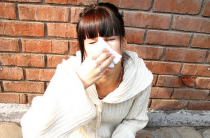An allergic reaction that occurs on the eyelids is one of the most common manifestations of allergies. The causes of allergies on the eyelids are diseases that are associated with malfunctions of the immune system.
This is due to the fact that the delicate skin of the eyes is very susceptible to various substances that cause the immune system to become hypersensitive.
Allergies on the skin around the eyes can be caused by the body's genetic sensitivity to any allergen. Often, allergies occur together with other diseases that are associated with malfunctions of the immune system (allergic rhinitis, bronchial asthma, atopic dermatitis).
In the course of life, we are constantly in contact with various microorganisms, microscopic particles of various origins, volatile substances that are found in large quantities in fruits, vegetables, or chemical compounds. Most people do not react to these substances in any way, do not feel their presence, but for some, their influence is palpable.
Many believe that an allergic reaction on the eyelids occurs only when an allergen affects the mucous membrane of the eye. But there are many cases in which redness of the eyes and tearing are provoked by eating foods, taking a drug to which a person has an individual intolerance.
Often, after direct contact with an allergen, an allergy occurs on the eyelids within five to thirty minutes.
When the allergen enters the stomach with food, it is absorbed into the mucous membranes of the eyelids through the bloodstream, which helps to slow down the onset of allergy symptoms for a couple of hours.
In a similar scenario, there is an allergy to insect venom, medication, or skin contact with an allergenic substance.
As well as allergies on the eyelids, other similar diseases can occur that are triggered by other causes. This may be the presence of decomatous blepharitis (which is caused by demodex mites), non-specific inflammation of the edges of the eyelids (due to increased sugar content, beriberi).
For this reason, first of all, eyelashes are handed over for microscopic examination. They also conduct a general examination.
When a person has an allergy on the eyelids, he must definitely visit an allergist. He will be able to order samples, with the help of which a specific factor will be determined, and they will take all measures to eliminate it.
The exact cause of the allergic reaction on the eyelids has not yet been established. Due to the fact that the skin on the eyelids is very sensitive and tender, very often in contact with the outside world, particles of substances flying in the air, it most often occurs due to exposure to external components.
The most common cause of an allergic reaction is a reaction to decorative cosmetics of poor quality. An allergic reaction can be caused by many factors:
- food products;
- poplar fluff;
- pollen;
- animal hair;
- dry food for fish;
- chemical components in washing powder;
- household dust.
Very rarely it is caused by drugs - eye drops, ointments or injections.
Factors predisposing to "eye" allergies
Eye allergies can occur in any season and under any circumstances. It is quite difficult to say exactly which substance provokes an allergy, since it is not always possible to say for sure whether it is an allergy or an eye disease.
There are the following factors that contribute to the development of allergies in the eyes:
- Hereditary predisposition (when one or both of the parents suffered from allergies, that is, there is a high probability of passing it on to the child);
- Tendency to constant diseases of the respiratory tract.
When a person knows that he has a predisposition, you need to know exactly what symptoms characterize an allergy so as not to confuse it with other diseases.
Symptoms
The amount of allergens that enter the body determines the severity of the symptoms, their duration.
Allergy on the eyelids is characterized by the presence of the following symptoms:
- itching;
- burning sensation;
- feelings of heaviness of the eyelids, their tension;
- too much light sensitivity;
- tearing;
- redness of the conjunctiva;
- swelling of the conjunctiva and eyelids.
If the stage of this disease is running, control over the ability of the eyelid to move is lost. Some cases are characterized by mucous discharge from the eyes, which indicate the presence of a bacterial infection.
Varieties of the disease
Allergies on the eyelids of the eyes are divided into several types, depending on what is the irritant.
So the patient may suffer from:
- Allergic conjunctivitis - redness and irritation of the mucous membranes of the eyes, and the skin of the eyelids;
- Spring conjunctivitis - occurring in adolescents under twelve years of age, has a chronic form;
- Infectious-allergic - occurs if there is an infection of a bacterial nature, has a chronic form;
- Medicinal - manifested after an hour after taking the medicine;
- Pollinous - manifested during the flowering period of trees, herbs, bushes, provokes its pollen;
- Chronic - with indistinctly expressed symptoms and constant relapses.
Such reactions are sometimes year-round or seasonal, acute or chronic. A common cause of an allergic reaction is the use of poor quality decorative cosmetics or one that contains ingredients that provoke allergies.
The cause of allergic reactions - eye shadow
Especially popular among decorative cosmetics are eye shadows, they can act as:
- Dry shadows - a dry powder base, which is obtained by pressing. It is the most popular in the cosmetics market. Dry shadows consist of talc, chromium hydroxide, zinc dioxide, magnesium and zinc stearates, kaolin, pearlescent and coloring pigments;
- In the form of a pencil, which is used for quick makeup. It can be a regular pencil or with a retractable lead. It contains harmless wax mixtures or fatty substances.
- In creamy form or in the form of liquid shadows, which are oil-based decorative cosmetics. They consist of a mixture of ceresin, paraffin, wax, stearic acid, fat-like substances.
Allergy on the skin around the eyes provokes most often the use of shadows in the form of a powder. This is due to the fact that microscopic particles of shadows fall on the conjunctiva of the eyes and cause irritation. One of the serious indicators of refusing to use eye shadow is individual intolerance to their components.
Pencil or liquid eye shadows are less of a threat because they don't flake off and thus can't irritate the eyes. Particular attention is paid to the pigments that make up the shadows. They can be organic compounds or mineral components. Cosmetologists recommend using shadows that contain mineral components instead of organic derivatives, which can provoke an allergic eye disease and increase the sensitivity of the skin around them.
The constant use of any cosmetic product can provoke allergic reactions due to the accumulation of various elements in the body. For this reason, decorative cosmetics should not be used for a long time, washed off at night, and periodically replaced with analogues from other companies.
Diagnosis of the disease
Before treating allergic reactions, a consultation is held with a specialist who examines the affected areas and gives the patient directions for the tests he needs. Most often, the patient needs to pass general urine and blood tests, undergo bacteriological and cytological examinations of the mucous membranes. In some cases, a biochemical blood test and an immunogram are prescribed.
When the disease is in remission, specialists prescribe a skin test: sublingual, conjunctival, nasal. These tests make it possible to determine which substance is causing the allergy and help prevent the development of this disease in the future.
Treatment of the disease
Allergies to the skin around the eyes are treated according to a scheme similar to the treatment of other types of allergies. At the first stage, diagnostics are carried out, then contact with the allergen is excluded, and then antihistamines are taken, which allow you to get rid of the symptoms of the disease. More serious manifestations of the disease are eliminated with the help of hormonal drugs, antibiotics.
Allergens are most often cosmetic products saturated with phospholipids, protein molecules, polysaccharides. To prevent the development of the disease in the future, new decorative cosmetics are tested on a small area of skin. The best solution for people with hypersensitivity to cosmetics is the use of therapeutic cosmetics that do not contain preservatives and additives.
Our consultant will answer any question you are interested in about the causes of allergies on the eyelids.















